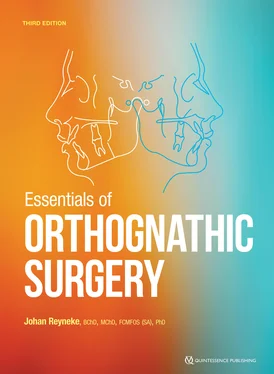Fig 1-6A 15-year-old patient reported an inability to bite certain foods with her front teeth. She recalled that she had an open bite before orthodontic treatment. Her four first premolars were removed as part of her orthodontic treatment, which lasted 2 years. Her bite was good at the time of band removal. Her frontal (a) and profile (b) views revealed a convex profile, maxillary vertical excess, and mandibular anteroposterior deficiency. (c) She had a Class II anterior open bite malocclusion. (d) The skeletal soft tissue and dental relationship is evident on the cephalometric tracing. The patient was rebanded and the maxillary arch aligned in three segments; the anterior segment contained the incisors, whereas the right and left posterior segments included all the teeth from the canines to the second molars. The surgery consisted of a three-piece Le Fort I maxillary osteotomy with superior repositioning and expanding of the posterior segments, which allowed the mandible to autorotate. The chin was advanced by means of a sliding genioplasty. The acceptable esthetic and functional result is seen in the postoperative frontal view (e) and profile (f) as well as in the occlusion (g) .
Patient Consultation
There will be separate consultations with the orthodontist and with the surgeon, and each will have both an initial consultation to inform the patient about treatment and a definitive consultation to begin the treatment. Before the final consultation with the patient, the orthodontist and surgeon will formalize and agree on a diagnosis and treatment plan.
First orthodontic consultation
Because people with malpositioned teeth and a jaw deformity usually seek treatment from an orthodontist, the orthodontist must usually discuss the possible need for a surgical procedure at the initial consultation. During the first orthodontic consultation, a clinical examination is performed and the appropriate records obtained. The surgeon will need a copy of these records as well.
Definitive orthodontic consultation
The final pretreatment consultation takes place only after a systematic patient evaluation has been conducted and the orthodontist and surgeon have agreed on a final treatment plan. It is mandatory that the patient (and perhaps the parents or spouse) be well informed. Well-informed patients follow instructions and, as a general rule, are easy to treat.
Orthodontists and surgeons should develop their own methods of informing patients about treatment options and gaining their confidence. It is important to keep explanations simple and to use the patient’s radiographs and dental casts to demonstrate the problems. Solutions for the problems should be discussed in general terms, and the need for surgery must be explained. The patient and their family (if applicable) must understand the importance of properly aligning the teeth, and that the bite may not improve or even get worse during the preoperative phase. Word choice is important for the orthodontist in discussing the type of surgery required. Terms such as reposition , lengthen , or shorten should be used when describing the surgical procedures. The final and more detailed explanation of the surgery should be left to the surgeon. Treatment results of patients with similar problems may be used to demonstrate specific treatment objectives.
For most patients, the treatment time is extremely important, but it is preferable not to give a specific length of time. It is important, however, to give the patient a general idea of the length of treatment and a treatment profile explaining various phases of the treatment, the sequence of the stages, and the time each phase could take. The patient should be alerted to factors that might influence the treatment time and surgical precision, such as bone density, periodontal disease, patient cooperation, age, and tooth extractions. It is also important at this stage to inform the patient about the cost of the orthodontic aspect of the treatment.
Explanation of typical treatment profile
A typical treatment profile consists of six phases:
1 Placement of orthodontic bands on the teeth. Any necessary extractions of teeth (including third molars) are completed at this time. The orthodontic bands are usually fitted 2 to 3 weeks later.
2 Preoperative/preparatory orthodontic phase (9 to 18 months, on average). The teeth are now aligned in their optimal positions in each arch. When the orthodontist is satisfied that this preparation is complete, the patient is referred back to the surgeon.
3 Surgical phase and healing time (4 to 6 weeks). The surgeon surgically repositions the jaw or jaws into their most favorable relationship to establish a good occlusion (bite) and balanced facial proportions. After a short healing period, the patient returns to the orthodontist for the final correction of the bite. It is very important that the patient see the orthodontist 2 to 3 weeks after surgery for postoperative orthodontic control.
4 Postoperative orthodontic phase to perfect the bite (3 to 6 months). The purpose of orthodontics after the surgery is to refine the bite. Minor tooth movement occurs during this phase to finalize the occlusion and achieve a satisfactory result.
5 Removal of orthodontic bands.
6 Retention phase (6 to 12 months). When orthodontic treatment has been completed, the teeth that have been moved through bone need to be stabilized in their new positions for a time. The orthodontist manufactures and fits a retention appliance, which must be worn by the patient as instructed by the orthodontist.
The duration of the presurgical orthodontic phase will vary as the severity and type of malocclusion varies. For example, mandibular advancement will be performed earlier in the orthodontic phase for Class II deep bite cases than for mandibular setback cases. In fact, in some cases, the orthognathic surgery may be performed before the orthodontic treatment begins. When performing surgery first, it is mandatory that an acceptable, stable occlusion can be established at the time of surgery. This treatment approach requires an experienced and competent orthodontist and surgeon.
First surgical consultation
The initial surgical consultation includes a general discussion of the basic principles of combined orthodontic and surgical treatment and why surgery is necessary. Most patients are apprehensive at this consultation, and the fact that they may need surgery has often come as a surprise to them. The surgeon should therefore use this consultation as an opportunity to inform the patient about the orthognathic surgical principles and to gain the patient’s confidence. The importance of a comprehensive treatment plan developed by both the orthodontist and surgeon is explained. At this consultation, a systematic patient evaluation is conducted, and records are obtained if not previously sent from the orthodontist.
Definitive surgical consultation
The definitive surgical consultation is conducted once the orthodontist and surgeon have finalized a treatment plan. The need for orthodontic preparation before surgery is confirmed. The basic principles of the specific surgical treatment, general sequence of events of the surgical phase of treatment, hospitalization time, recovery period, and need for a soft food diet are discussed. The surgical objectives may be explained by treatment results of patients with similar dentofacial problems. A patient information brochure is provided, and the patient is reassured during the preoperative orthodontic phase that he or she is welcome to discuss with the surgeon any concerns regarding the planned surgery. The estimated costs, including costs of the planned surgery, hospitalization costs, and the anesthetization fee, should also be discussed at this time.
Читать дальше












